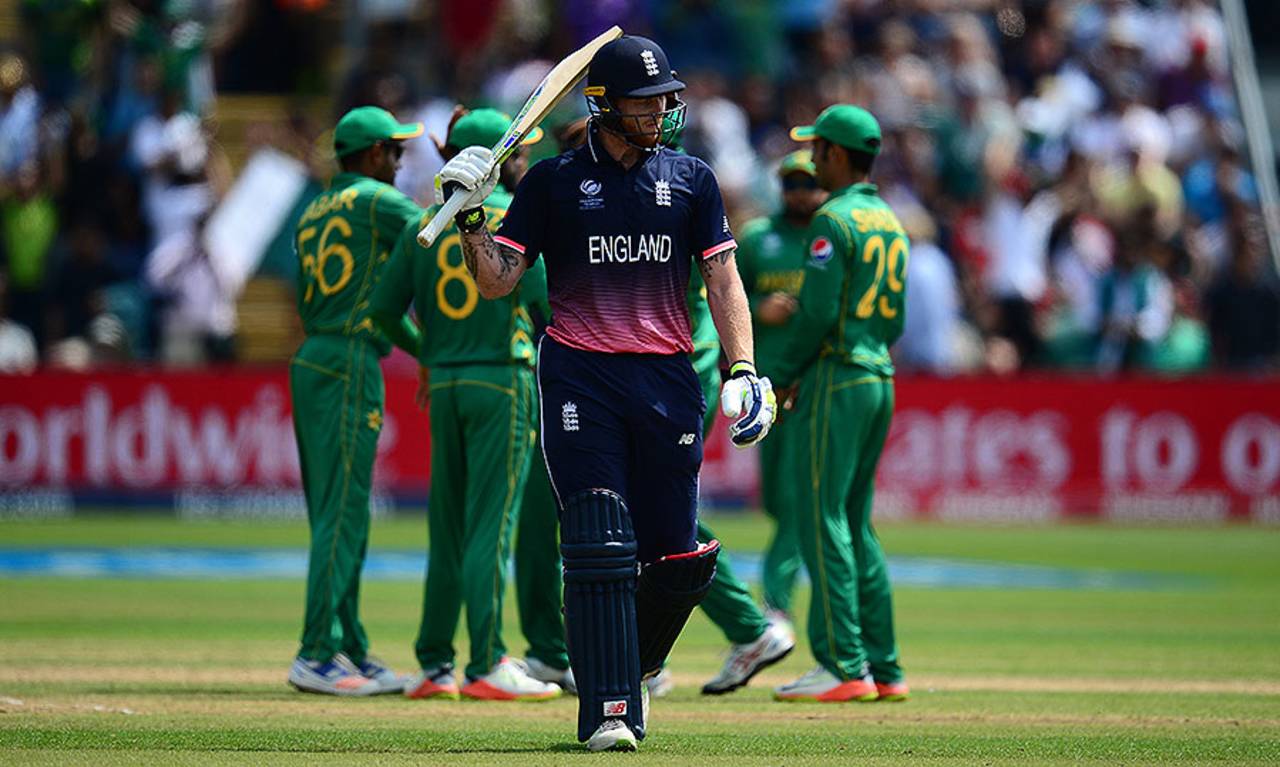Where was England's Plan B?
Amid the euphoria of their post-World Cup ODI revival, England showed fallibility in pressure matches and in less-than-perfect batting conditions. These very failings led to their undoing in a global semi-final on a tricky, used pitch in Cardiff
Andrew McGlashan in Cardiff
14-Jun-2017

Ben Stokes faced 64 balls without finding the boundary • Getty Images
The last time England and Pakistan met in the knockout stages of a one-day tournament was Melbourne in 1992. English hearts were broken by Imran Khan and Wasim Akram. It was also when they were last regarded as a genuine force in the 50-over game until this current crop of players came together over the past two years. Now, 25 years later, Pakistan have done it again. This time it was barely contest.
It had looked like the stars had aligned for England with the bowling attack, even in the absence of the injured Chris Woakes, finding its teeth during the matches against New Zealand and Australia to supplement an awe-inspiring batting order. They were the only unbeaten team through the group stage and the one issue was the form of Jason Roy, who lost his place to Jonny Bairstow for the semi-final.
Even that change appeared to have improved things for England. Bairstow made 43, albeit not entirely convincingly, in a solid start. Unlike 1992, the lbws went England's way too: Bairstow was saved by a narrow umpire's call off the second ball of the match and Alex Hales reprieved after he'd been given out to one that pitched outside leg. They were also facing a Pakistan attack without Mohammad Amir, who had been ruled out with a back spasm.
Instead it turned into a punishing day. The mitigation of it being a tricky used pitch - the same one which had hosted the final group game two days ago - quickly diminished as Pakistan made light of conditions. Fakhar Zaman, one of the finds of the tournament, broke the back of the chase with a century stand alongside Azhar Ali at more than five-and-a-half an over. In every aspect of the game, Pakistan were better.
There had been signs that England would struggle to blaze their way to 300-plus, but little to suggest the demise which would unfold when they were 128 for 2 in the 28th over and on course for at least 250. Then Joe Root edged a cut against Shadab Khan, having not found the boundary for 36 deliveries. From the 30-over mark of the innings, when England have so often more than doubled their score, they managed just three fours amid some outstanding bowling.
But even allowing for the quality of the bowling, England appeared timid. One of the questions asked of this side is how they adapt when 300 isn't par, or even below par. There had been glimmers of a different approach on slower pitches in the West Indies earlier this year, but the opposition were poor. When the ball zipped around against South Africa at Lord's and called for some circumspection they were 20 for 6. This time the damage did not come early, but when the boundaries dried up there did not appear a Plan B.
Was it the pressure of the knockout scenario? For all the success and run-gorging over the last two years, this was the highest-pressure game the side had faced. Also, during their post-World Cup revival there have been examples of England collapsing even with a bilateral series on the line. It happened against Australia in 2015, when they were skittled for 138 at Old Trafford, and South Africa last year in Cape Town. Some might point to last year's World T20 final as another example of where they failed in the pressure situation, but that ultimately came down to an over after they had hauled themselves back into the match. When this performance started to go badly, it spiraled and was never retrieved.
The innings swung between an attempt to keep the attacking mantra going - Bairstow's top-edge to deep square leg and Eoin Morgan's run down the pitch and swing at Hasan Ali - and an inability to then milk the bowling when the going was tough. Ben Stokes had appeared to leave his timing at Edgbaston, facing 64 balls without a boundary of which 34 were dot balls.
In England's innings as a whole there were 160 dot balls (their fifth-most since the World Cup) and if only 50 of those had become a single, 250 was there for the taking - a target that would have seen Pakistan start the chase under more pressure. There was room for a more drop-and-run approach from the middle order.
They weren't without a chance defending 212 with a vulnerable Pakistan middle order, but they barely reached it. The openers took advantage of the hard new balls to skip well ahead of the rate and by the time spin was introduced in the 15th over the score was 81 without loss. Adil Rashid could be milked. Towards the end of the chase, Jos Buttler missed a stumping and there was a no-ball called when England had too many fielders on the leg side. Neither made a jot of difference but summed up their day.
So England's wait for a global one-day title will stretch to at least 44 years. The 2019 World Cup has always been stated as the ultimate aim, but that will be of scant consolation today. This will hurt. And for some time.
Andrew McGlashan is a deputy editor at ESPNcricinfo